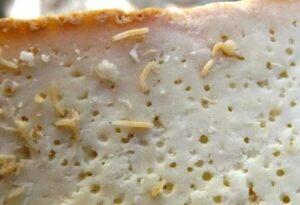Cheese Fly (Piophila casei)
Updated on
17/11/2022Cheese flies are small pests with metallic-colored bodies. Their larvae infest human food items like cheese, smoked or salted fish, cured meats, and carcasses. When such contaminated food is consumed, the larvae can live in the intestine, causing enteric myiasis. Their delayed infestation of decaying human parts has made them significant in forensic investigation.
Scientific Classification
- Class:Insecta
- Order:Diptera
- Family:Piophilidae
- Genus:Piophila
- Species:P. casei
Conservation Status
Description
The cheese fly is 0.16 inches (4 mm) long with an elliptical abdomen. Its body is black or bluish-black with bronze tints on its head, thorax, and abdomen. Its face is reddish, eyes reddish brown, and cheeks wide. The faintly iridescent wings lie flat on its abdomen when it is resting.
The proboscis and palps are generally covered with bristles, and the antennae are short. There are prominent rows of setae on the thorax and large ones on the sides. The short spine-covered legs are mostly yellow or brown colored.
Distribution: Worldwide, including the US.
Habitat: Most diverse in the boreal and temperate regions of the northern hemisphere.
Do They Bite/Sting: No.
Lifespan: 19-23 days.
Predators: The larvae are eaten by the red-legged ham beetle, Necrobia rufipes.
Behavior and Characteristics
Diet
The detritivores derive their nutrition from decaying matter. They commonly feed on moldy or overripe (3-4 months old) cheese and fetid or slightly salted meats like bacon, ham, and beef. The infested meats may have a shiny and greasy liquid dripping from them, and affected cheeses usually have soft and sunken areas.
Life Cycle
1. Egg Stage
The oval or cylindrical, pearly-white eggs are 0.63-0.74 mm long and 0.18-0.2 mm wide. 140-500 eggs are laid on cheese or meat. They hatch in around 23-54 hours at 15°C-27°C.
2. Larva Stage
The larvae are known as cheese skippers, ham skippers, bacon skippers, etc., as they can propel themselves several inches into the air when disturbed or alarmed. They are fairly cylindrical and all-white except for the scleratized black mouthparts. They are active as soon as they hatch and pass through 3 instars lasting nearly 14 days. The fully matured ones are white or yellowish-white, 9-10 mm long, and 1 mm wide.
2. Pupa Stage
The dark brown pupae are formed in dark and dry places or concrete floors almost 32 hours after the larvae abandon the feeding substrate. The oval puparium is 2.9-3.9 mm long and 1-1.17 mm broad. This stage lasts for around 12 days.
3. Adult Stage
The females are slightly larger than the males. The females start laying eggs after 10 hours of mating. The adults live for 3-7 days.
Getting Rid of Cheese Flies
Infested pantries or storerooms should be thoroughly cleaned, fumigated with sulfur, and washed with kerosene oil. Care should be taken to especially clean the cracks as the pupa may nest in those places. Rooms or receptacles should be screened to keep the flies out. Meats and cheeses should be kept covered.
Source
cdn.branchcms.com, live.staticflickr.com, alchetron.com











